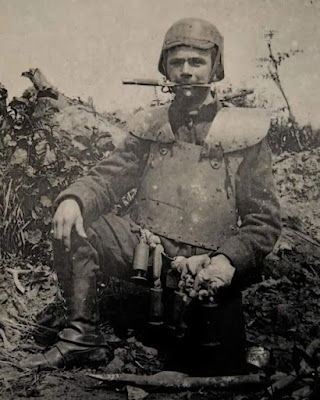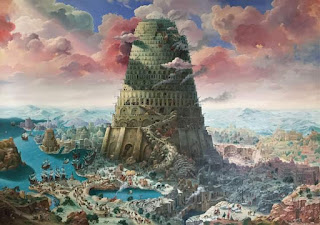Belgian soldier posing for a photograph in Italian Farina body-armour, 1917.
Today I'll write about the Italian Farina body-armour used during the First World War.
On May 23, 1915, Italy declared war on Austria-Hungary, and a bloody front along the Isonzo river ensued. The front soon bogged down into positional trench warfare, with layers of barbed wire protecting the trenches, which the Italians soon realized caused immense problems for their attacking soldiers.
On June 16, 1915, the Italians formed the so-called "Companies of Death" (Compagnie della Morte), whose arduous task would be to cut the barbed wire with wire cutters and to conquer the enemy trenches before the masses of infantry would attack.
As can be imagined given their name and task, the Companies of Death suffered heavy losses in their efforts, with many sacrificing themselves on the barbed wire for their fellow soldiers not to share the same fate.
To offer the Companies of Death more protection, the Farina body-armour was developed, named after its creator Ferruccio Farina.
The Farina body-armour consisted of a chestplate and two shoulder pads, each made from 1,5 mm steel, weighing 9 kg in total. A 4 cm thick steel helmet was also developed, weighing an additional 1,6 - 2,8 kg depending on its size. The armour was tested to be able to withstand a 6.5 mm caliber from a Carcano rifle from 125 m away.
Contrary to the German Sappenpanzer armour, made for soldiers in static positions such as snipers and machine-gunners, the Farina body-armour was made for the Companies of Death to advance and attack in.
Although good in theory, the Farina body-armour only slowed down the Companies of Death and made them extremely vulnerable to artillery. Once in the Austro-Hungarian trenches it didn't offer much bullet resistance at close range either.
By 1916, the Italians dissolved the Companies of Death, using artillery to blow away the barbed wire prior to assaults instead.
Contrary to popular belief, the Farina body-armour was never issued to the Italian Arditi shock troops for the aforementioned reasons.











Comments
Post a Comment